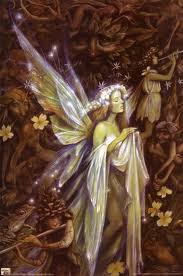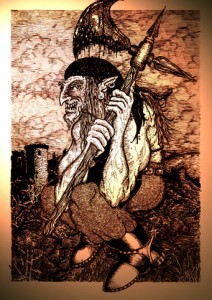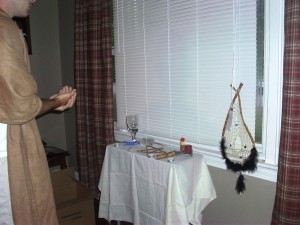Nearly every faith I’ve explored so far this year has them: Creatures that often straddle the spiritual and physical realms of reality. In some cases, they remain exclusively in the spiritual world, never to be seen by humans. In others, they are as real and present in our visible world as we are. Still some enjoy a dual citizenship across worlds. I’ve heard names such as angels, demons, fravashi, demigods, and hungry ghosts just to name a few.
For many forms of Wicca (and particularly Fey Wicca), there are many species of spiritual and physical beings which populate these planes. Some Wiccans believe in elementals, beings which embody one of the four elements. For Fey Wicca, the tradition which dominates my time this month, the Fey are the often hidden species of mythic, spiritual creatures often found in Celtic and Irish lore. Fey Wicca then, is a tradition that acknowledges these creatures as being as real as fish in a pond, living right below the surface of our visible world.
Fey Wicca is a path which seeks community and involvement with the various Fey, but what are these creatures? In general, the Fey are mischievous and fun-loving creatures, however the term “fun” is highly subjective. One person’s fun could be another’s nightmare. Some Fey are painfully gorgeous while others are frightfully hideous. Many can change form while others embody trees, stones, or streams. While I will try and place the wider world of the Fey below within a certain context it is important to understand that the Fey often defy our understanding and escape simple categories.

The Fey are free-willed creatures, just as we are, and as such generally fall into two “courts.” One is the Seelie Court, or “blessed court.” The terms Seelie and Unseelie come from Scottish lore and so these faeries aren’t necessarily part of faeries of other lore. The majority of those Fey in this court are sidhe (pronounced “shay”), that is, beautiful and fair-complected faeries. All Fey have a “code” or common characteristic by which they live. The Seelie Court lives by the following code:
–Death before dishonor
–Love conquers all
–Beauty is life
–Never forget a debt
In 99% of cases, Fey Wiccans seek the company of the Seelie Court. In a broad way, you could view the Seelie Court as the “good guys,” although concepts of good and evil are blurred in the wider world of Wicca and the Fey. In general, there is what is constructive and deconstructive, two parts of a whole that make up the universe. This idea is very specific to the Fey however, and because of this concept, the two courts of the Fey often collide.

The other side of the coin is the Unseelie Court. A member of this court is the antithesis of those in the Seelie Court. They are a highly diverse bunch and can be extremely dangerous. Some are known to attack lone travelers on dark roads, others abduct children who stray too far from home. They too live by a code:
–Change is good
–Glamour is free
–Honor is a lie
–Passion before duty
Because many Fey Wiccans actively commune with and seek the company of the Fey for various reasons, great care is taken with summoning their presence. It is critical that anyone seeking out these creatures be very specific in what they are looking for and how they go about the task. Just as you wouldn’t go looking for a doctor in a dark, filthy alley, you need to know where and how to find the Fey. Seek an experienced individual for help in this matter.
Could this be what happened to me with my Shaman experience? Had I invited the wrong beings into my life? Because virtually all Fey are considered chaotic to some degree, perhaps the being(s) that visited meant no harm, but like a gentle giant, their presence often terrifies without intention. Some have told me that it was a demon and are even worried for my safety this month. Others say it was a curious air elemental. There are also those times at the river in the Temple (a place of meditation I’ve often visited this year). The last time I was there, I felt as if I was being watched. Was it the Fey?
If one faith believes in the existance of invisible beings such as angels or demons, is it so hard to believe in the Fey? Why does one faith’s lore cancel out the other? Perhaps we are giving different names for the same things…

